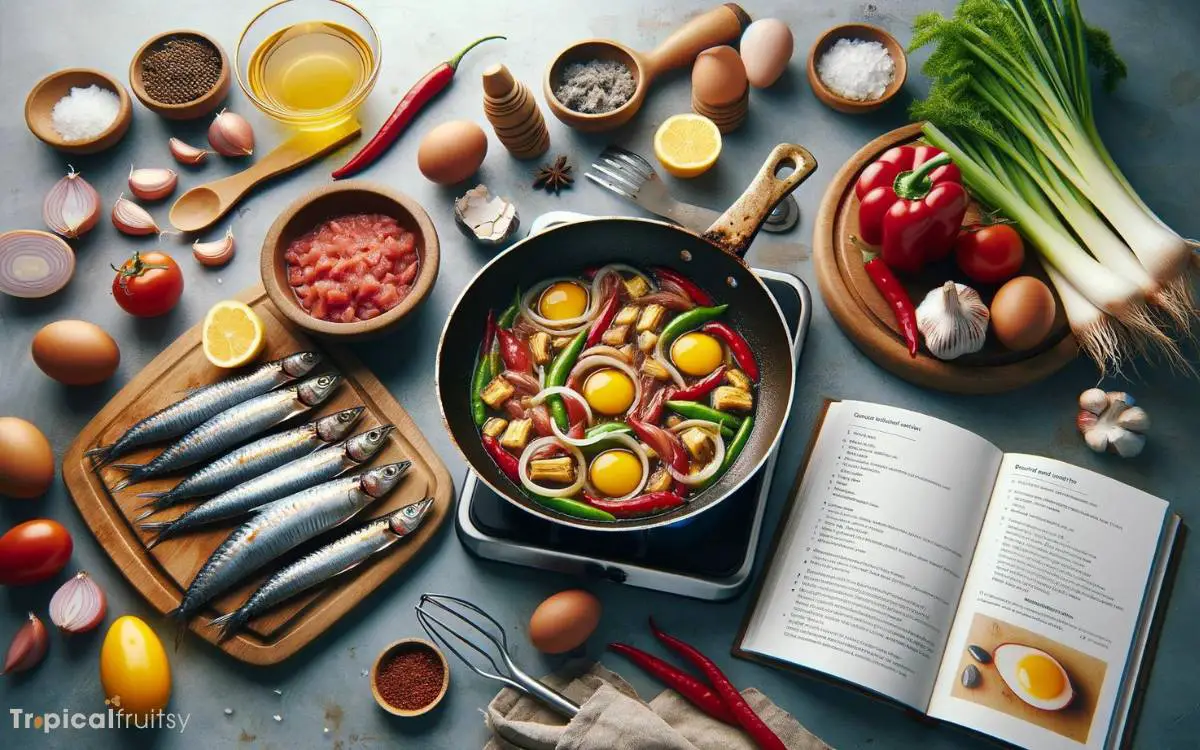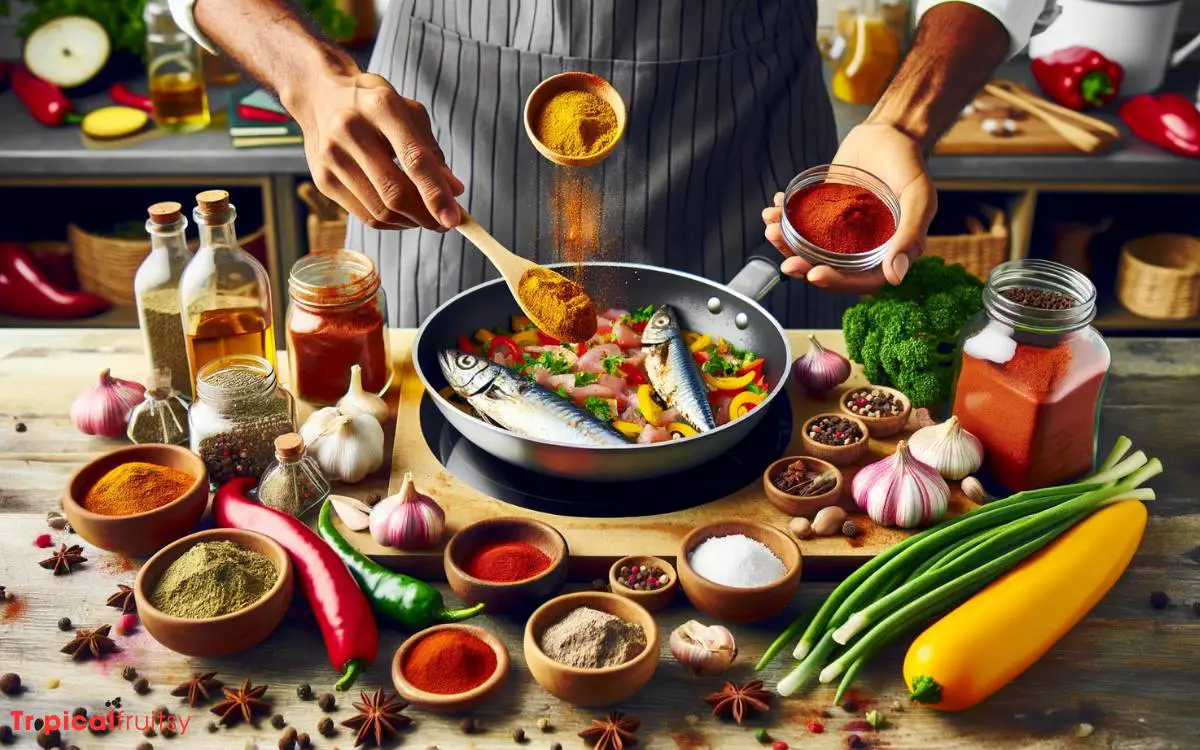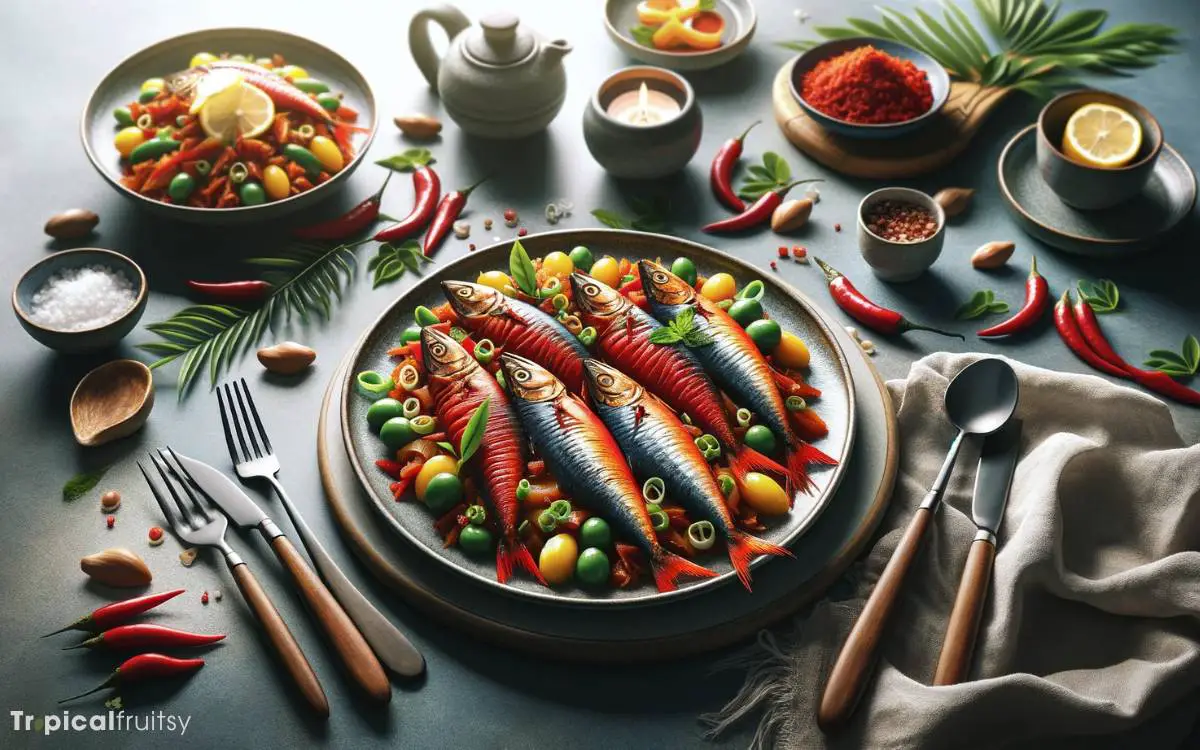How to Cook Red Herring and Ackee? 6 Easy Steps!
Red herring and ackee, a quintessential Jamaican dish, offers a delectable fusion of flavors that is both unique and satisfying.
The dish combines the robust, smoky taste of the red herring with the delicate, buttery texture of the ackee, Jamaica’s national fruit.
In preparing this dish, one must first procure high-quality, salt-cured red herring and ensure that the ackee, whether fresh or canned, is properly cleaned and prepped.
The cooking process involves a careful balance of spices and a methodical approach to ensure the herring’s saltiness complements the mildness of the ackee without overwhelming it.
This guide will provide a comprehensive overview of the techniques required to master the art of cooking red herring and ackee, delivering a dish that is not only traditional but also infused with a depth of flavor that is sure to delight the palate.

Key Takeaway
Step 1: Sourcing Your Ingredients

To prepare red herring and ackee, one must first procure fresh ackee pods and high-quality, salt-cured red herring from reputable markets or specialty grocers.
The task demands discernment; seek out ackee that is bright red to yellow-orange, indicating ripeness, and ensure the flesh within is firm to the touch and cream-colored.
For the red herring, the aroma should be pungently briny, a testament to traditional curing methods, and the texture resilient yet pliable.
These ingredients are the bedrock of the dish’s authenticity, imbuing it with the distinctive flavors that define Caribbean cuisine.
In the hands of a knowledgeable cook, these elements transform into a harmony of taste that is both robust and delicate.
Step 2: Preparing the Red Herring

Before embarking on the cooking process, it is essential to properly desalt the red herring by soaking it in cold water for several hours or overnight, changing the water periodically to remove excess salt.
This initial step is non-negotiable, as it tempers the briny vigor of the fish, rendering it palatable and ready to meld with the gentle richness of the ackee.
Once the herring has been sufficiently desalted, it’s time to attend to its texture. Gently flake the softened fish, carefully discarding any bones that could mar the eating experience.
This methodical preparation honors the herring’s robust character while ensuring it harmonizes with the delicate flavors of the subsequent ingredients. Mastery of this stage sets the foundation for a dish that resonates with tradition and taste.
Step 3: Cleaning and Slicing Ackee

Turning our attention to ackee, the fruit’s unique texture and flavor profile demand meticulous preparation before it graces the plate.
Beginning with a gentle twist to open the ripe pods, one must deftly remove the toxic black seeds and the red membrane, ensuring the safety and purity of the fruit.
The art of slicing ackee is one of precision, aiming for uniform pieces that will cook evenly, unlocking the dish’s full potential.
Ackee Pod Opening
Begin preparing ackee by selecting a ripe pod, which should be yellow to red in color and naturally split open, indicating readiness for cleaning and slicing.
The splendor of ackee lies not only in its rich, buttery flavor but also in its delicate preparation process.
Gently cradle the open pod in your hands, and with a practiced touch, ease the arils—the edible portions—from the black seeds, which are discarded.
Be vigilant to remove any traces of the pinkish membrane, as it can harbor toxins. Once liberated from its casing, slice the arils carefully, maintaining the integrity of their soft, creamy texture.
The cleaned ackee is now a blank canvas, ready to absorb the bold flavors of the red herring in your culinary composition.
Seed Removal Techniques
Every ackee aril must be meticulously cleaned of its toxic black seeds and membranous tissue before it is deemed safe for consumption. This vital step ensures the rich, buttery fruit can be savored without concern.
Here’s how to purify these golden morsels:
- Gently Pry: Use a small, blunt tool to carefully pry the black seeds away from the delicate flesh. This minimizes damage to the aril itself, keeping it plump for your dish.
- Peel Away Tissue: Remove the red membrane that may cling to the ackee’s lobes. It’s a reminder of the fruit’s unripened state and has no place in your cuisine.
- Slice with Precision: Cut the cleaned ackee into uniform pieces, ensuring each bite offers an even taste and texture that complements the assertive flavor of red herring.
Slicing for Cooking
Once the ackee has been cleared of its toxic elements, it is essential to slice it properly for even cooking and optimal flavor integration with the red herring.
Begin by gently rinsing the ackee lobes under cold water, taking care to maintain their delicate structure.
With a sharp knife, slice the ackee into uniform pieces, ensuring they are of similar size to promote consistent cooking.
The art of slicing ackee is akin to preserving its buttery texture; it should be done with reverence for the ingredient and anticipation for the dish that’s to come. As each piece is prepared, the stage is set for a symphony of flavors.
Now, the canvas is ready for the culinary artist to masterfully combine flavors and spices.
Step 4: Combining Flavors and Spices

The culinary dance of red herring and ackee is heightened when the right balance of spices meets the boldness of the fish and the subtle creaminess of the fruit.
Mastering the art of spice intensity ensures each bite is a harmonious blend of heat and flavor, without overpowering the dish’s delicate elements.
A savvy understanding of complementary flavor pairing and refined herb infusion techniques is key to crafting a dish that resonates with authenticity and leaves a memorable palate impression.
Balancing Spice Intensity
Commonly, when preparing red herring and ackee, achieving a harmonious balance of spices is crucial to complement the dish’s robust flavors without overwhelming the palate.
The interplay of spices should enhance the natural savoriness of the herring and the subtle, buttery notes of the ackee.
To master this culinary nuance:
- Moderation: Start with smaller amounts of potent spices, such as Scotch bonnet peppers, and incrementally adjust to taste.
- Complementary Pairing: Use spices like thyme and garlic to underscore the smoky undertones of the herring without masking its inherent taste.
- Acidic Balance: Incorporate a splash of vinegar or lime juice to cut through the richness and refresh the flavor profile.
Each spice should whisper its presence, melding seamlessly into a symphony of taste that resonates with authenticity and sophistication.
Complementary Flavor Pairing
Mastering the art of combining flavors and spices is essential for the perfect marriage between the smoky red herring and the creamy texture of ackee. To achieve a symphony of taste, one must consider the potency of each ingredient.
The boldness of red herring benefits from the subtle backdrop of ackee, which absorbs and melds with the fish’s robust character.
Complement this duo with the warm piquancy of allspice and the bright spark of Scotch bonnet peppers, tempered to enhance without overpowering.
Fresh thyme lends a fragrant note, while the sweetness of sautéed onions balances the dish’s inherent savoriness.
This careful curation of flavors creates a dish that is harmonious and satisfying, offering a culinary experience that resonates with authenticity and depth.
Herb Infusion Techniques
Utilizing a variety of herbs, each in careful measure, can significantly elevate the nuanced flavor profile of red herring and ackee. The harmony of flavors should not be accidental but instead a symphony of well-thought-out choices.
To achieve this:
- Layering: Start with a base of hardy herbs such as thyme and bay leaves, introducing them early to the dish so they release their full spectrum of flavors.
- Balance: Counter the robustness of red herring with fresh, zesty notes from herbs like cilantro or parsley, adding them towards the end of the cooking process to preserve their vibrant taste.
- Infusion: For a subtle background note, gently simmer the ackee with rosemary or sage, allowing the oils to infuse without overpowering the dish.
Each herb plays a pivotal role, transforming the simple act of cooking into an art of flavor.
Step 5: Cooking Method and Tips

In preparation for cooking red herring and ackee, one must first desalt the herring by soaking it in water overnight to ensure the right balance of flavors. Once desalted, gently simmer the herring until it’s tender, then flake the fish, discarding any bones.
For the ackee, if using fresh, wait until the pods naturally open, then clean and boil the ackee in lightly salted water until soft but not mushy.
If canned, simply drain and rinse. In a skillet, sauté onions, garlic, Scotch bonnet pepper, and thyme, creating a fragrant base.
Introduce the flaked herring, followed by the ackee, folding gently to prevent the ackee from breaking. Serve this iconic Jamaican dish warm, allowing the nuanced flavors to shine.
Can I Substitute Saltfish with Red Herring When Cooking Ackee?
Yes, you can substitute saltfish with red herring when cooking ackee if you want to cook ackee without saltfish. Both types of cured fish can be used to enhance the flavor of the dish and provide a similar texture. Just be mindful of the salt content when making the switch.
Step 6: Serving and Presentation

Upon completion of the cooking process, attention must turn from the kitchen to the table for the serving and presentation of the red herring and ackee.
This dish, rich in cultural heritage, deserves a presentation that complements its robust flavors and vibrant colors.
To ensure that your dish is as pleasing to the eye as it is to the palate, consider the following:
- Plating: Use a warm, earth-toned plate to contrast the bright yellow of the ackee, allowing the red herring’s deep hue to stand out. A clean white plate can also make the colors pop.
- Garnish: Sprinkle freshly chopped herbs like parsley or scallions to add a fresh green accent and enhance the dish’s visual appeal.
- Accompaniments: Serve with traditional sides such as fried dumplings or boiled green bananas, arranged neatly around the ackee and herring to create a balanced and inviting plate.
Conclusion
The marriage of red herring and ackee represents a quintessential fusion of robust flavors and cultural heritage.
Mastery in the preparation of both ingredients ensures a dish that sings with authenticity and provides a culinary experience that is greater than the sum of its parts.
When properly executed, this traditional fare not only nourishes the body but also provides a feast for the senses, embodying the very essence of a cultural mosaic on a plate.






